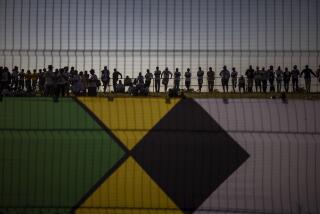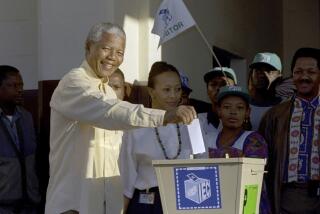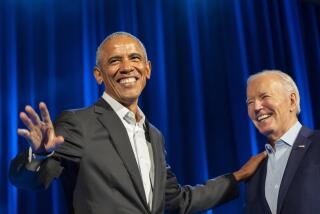Throngs Cheer Mandela as Trip to U.S. Begins
NEW YORK — Nelson Mandela, whose sacrifices for black liberation in South Africa have made him a legend at home and abroad, was cheered Wednesday by hundreds of thousands of exuberant New Yorkers, serenaded by choirs and showered with a paper blizzard in a historic ride up Broadway’s “Canyon of Heroes” as he began his first visit to America.
The emotional outpouring of support for the 71-year-old leader and his wife, Winnie, began the moment they set foot on a red carpet at Kennedy International Airport, where they were embraced by black and white political leaders from three states and applauded by a crowd bathed in the black, green and gold colors of Mandela’s movement, the African National Congress.
“You, the wonderful citizens of New York, have demonstrated in the most visible manner that we, the oppressed people of South Africa and the ANC, are admired and respected (and) that it is the dying apartheid system that is totally isolated,” Mandela told a crowd on the steps of City Hall, where he accepted the key to the city from Mayor David N. Dinkins.
“(We) are overwhelmed by the extraordinary reception that we have received,” said Mandela, dressed in a blue suit. He was accompanied by his wife, who was wrapped in a traditional red-and-white African dashiki. “No . . . words can ever express the deep emotions I feel at this moment.”
New York Gov. Mario M. Cuomo, who rode with the Mandelas on the parade route, described the hero’s welcome as “the single most memorable thing I’ve ever witnessed,” and he attributed it to the couple’s “strength, their indomitability. It is what they demonstrate that you can do when your heart is filled with righteous passion.”
“It was a colossal shout in one magnificent voice, to say to the world that it’s time for the chains to be thrown off. Put an end to apartheid in South Africa. Put an end to the evil,” Cuomo said.
Mandela’s motorcade from the airport wound through neighborhoods of Brooklyn, scene of some of New York’s recent racial strife, where throngs lined the roadway and pressed forward to touch the black limousine carrying the man Dinkins later called a “modern-day Moses” for blacks worldwide.
Mandela then climbed into a special vehicle with large bulletproof windows and, thickly surrounded by dozens of uniformed and plainclothes security officers, moved up the narrow skyscraper canyon of lower Manhattan as it rained tons of scraps of paper, including some authentic pre-computer age ticker tape imported from Connecticut.
As Mandela and his wife waved to the noisy revelers, fists shot into the air with the traditional salute of the ANC, the liberation movement that, until a ban was lifted in February, had been outlawed by the white authorities in South Africa for 30 years.
Construction workers waved their hats, schoolchildren carried signs reading: “Hooray You’re Free!” and black as well as white office workers in suits and ties applauded from open windows. Some even ventured out onto narrow ledges high above the street in New York’s financial district.
Police estimated the crowds at 750,000 and said there were no major incidents. A contingent of 12,000 police officers, some using bomb-sniffing dogs, was deployed to guarantee Mandela’s safety. The $2-million tab, mostly for overtime, was being picked up by the federal government.
“There’s a nice, warm feeling of camaraderie here today,” said Rabbi Gilbert S. Rosenthal, executive vice president of the New York Board of Rabbis, as the motorcade passed. “It’s a great welcome for a great hero.”
Another spectator, Lorenzo Grooms, 19, standing ankle-deep in shredded paper, was exultant. “It was incredible--he looked right in our face,” Grooms said.
Among the other dignitaries who crowded a platform erected in front of City Hall were movie director Spike Lee, Dick Gregory, Harry Belafonte, the Rev. Jesse Jackson and former New York Mayor Edward I. Koch.
Mandela’s 12-day, 8-city visit to the United States, which includes a stop next week in Los Angeles, has been heralded by ANC leaders as an opportunity to thank Americans for their support and urge them to pressure President Bush and Congress to maintain economic sanctions against Pretoria until the last vestiges of apartheid are gone.
Mandela has meetings scheduled next week with Bush and will address a joint session of Congress. Mandela’s New York schedule includes an address at the United Nations and several fund-raisers, from a $5-a-seat rally at Yankee Stadium tonight to a $2,500-a-person dinner Friday.
After delivering three speeches during a whirlwind five hours, Mandela was taken to the mayor’s official residence, Gracie Mansion, where he spent the night. Organizers of the journey, concerned about Mandela’s health, canceled several private evening meetings and a dinner party.
Roger Wilkins, national coordinator of the U.S. tour, said that, although Mandela seemed well throughout the day, it had become clear after the last speech at City Hall that “he had reached a limit that shouldn’t be pushed.”
And Wilkins said he has been urging local organizers in other cities to trim Mandela’s itinerary so that he will have more rest. “We’re probably going to have to thin it out as we go,” Wilkins said.
Mandela, who turns 72 on July 18, has traveled to dozens of countries since his Feb. 11 release from a South African prison, where he had served 27 years of a life sentence for founding the ANC’s guerrilla campaign against the white minority government in Pretoria. He underwent minor bladder surgery last month and went on the road a day after his hospital discharge, beginning a six-week trip that already has taken him through Europe and Canada.
The ANC leader, who suffers from high blood pressure, is traveling with a doctor.
New York City came to a virtual standstill at midday when Mandela arrived, about two hours late, aboard a Canadian government jet. Organizers blamed the delay on the need to give Mandela more rest. New York television stations broadcast continuous coverage of the ANC deputy president’s every move, preempting most of their daytime afternoon programming, and the city’s tabloid newspapers offered front-page headlines of welcome, with the Daily News saying: “Cry Freedom” and New York Newsday announcing: “It’s Red Carpet Time.”
After being described in glowing terms by Dinkins and Cuomo, Mandela returned the compliments, telling Dinkins that his election as the first black mayor of New York “filled me and our people with pride. We fully support your struggle to heal the wounds of this city.”
Mandela said he had read about “the powerful oratory and sharp analytical mind” of Cuomo, “and I must say now, having heard you speak, that what we heard is no exaggeration.”
Mandela’s 54-year-old wife, herself subjected to years of harassment, detention and banishment by South Africa’s authorities, addressed the crowd at City Hall in one of her rare public speeches since her husband’s release.
“You have helped us go through the most difficult years in our struggle for freedom,” she said. And she thanked Americans “for the solidarity you gave us when we were in jail, when I was in (internal) exile and when I was in the bigger prison called South Africa.”
Earlier, the Mandelas stopped in the heart of Brooklyn’s predominantly black Bedford-Stuyvesant neighborhood at a high school where an estimated 10,000 students and residents had turned out to see them--and where their thoughts were on the racial divisions in their own city.
“Look at all my people!” said Gloria Mingo Jackson, a Brooklyn schoolteacher. “We’re together. We’re not fighting. We’re going to get it together as a people. This is something I’m going to tell my grandchildren.”
Many of Mandela’s fans said they especially admired him for his principled stand in prison, where he had refused government offers of freedom in exchange for a renunciation of the ANC’s strategy of armed struggle.
“He has given up his whole life” for black liberation, said Erna Letemps, 21, who had come from Orange, N.J., to see Mandela at the school. “He knew what the struggle was and he stuck to it.”
Among the crowd outside City Hall in Manhattan, 76-year-old James C. Campbell, a sergeant in an all-black regiment during World War II, said he respected Mandela for holding his ground over a principle.
Margaret Gadsden, a telephone operator, brought her four grandchildren “to see a hero.” She said: “He’s an important figure for us. I don’t care what color you are, we have to work together for equality. That’s what this is all about.”
Mandela alternately urged continued sanctions against his country’s government and financial help for his organization, which is beginning the massive task of re-establishing itself as a political entity inside South Africa. Although one of many political organizations representing the voteless black majority in South Africa, the ANC in the opinion of most analysts has the greatest support among the 27 million blacks. The ANC supports one-person, one-vote rule on a universal voters roll, and it has been slowly gaining support among the 5 million whites there.
“We can see the light at the end of the tunnel,” Mandela said Wednesday. “We are therefore appealing to you in all humility and in all sincerity that you must join us” by maintaining American sanctions against South Africa and donating money to the ANC cause.
The ANC believes sanctions against Pretoria have forced President Frederik W. de Klerk to initiate a series of rapid reforms in the past four months. De Klerk’s actions have freed up black political activity and lifted many of the most onerous security measures used by the authorities to put down anti-government protest. This week he also pushed through Parliament legislation that eliminates one of the pillars of apartheid, the Separate Amenities Act, which allows city councils in South Africa to segregate public facilities such as libraries, recreation halls, parks and swimming pools.
However, other important apartheid laws, including those that mandate segregated residential areas and schools, remain.
Zwelakhe Sisulu, one of Mandela’s aides, predicted that “a lot of black South Africans are really going to feel good about what happened today, with black and white people praising Mr. Mandela. And it’s going to get a lot of white people in South Africa thinking seriously about the future of their country.”
Staff writer Edwin Chen contributed to this story.
HAPPY CROWD--Thousands of New Yorkers wait for hours for a glimpse of Nelson Mandela. A18
OTHER COVERAGE: A18, 19
More to Read
Sign up for Essential California
The most important California stories and recommendations in your inbox every morning.
You may occasionally receive promotional content from the Los Angeles Times.












